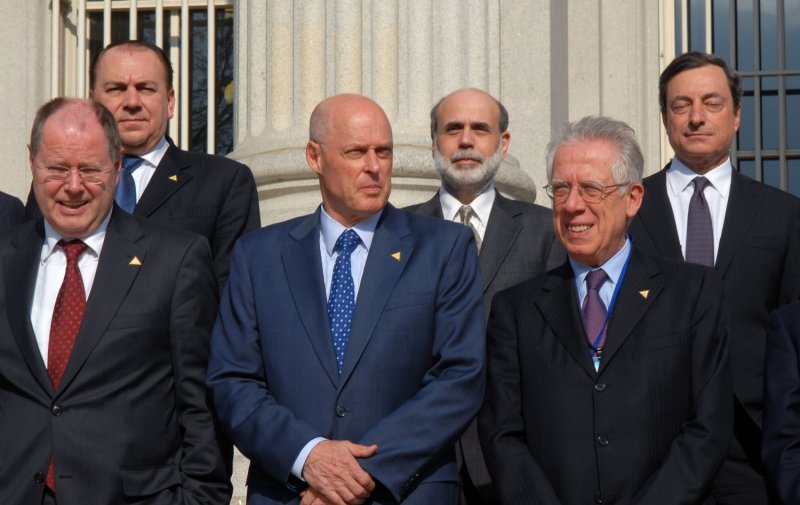G-7 Summit Central Bank Governors and Finance Ministers stand for a photo outside the Treasury Department during the G-7 Summit in Washington on April 11, 2008. From left, Peer Steinbruck, Germany, Axel A. Weber, Germany, Henry Paulson, United States, Ben Bernanke, United States, Tommaso Padoa-Schioppa, Italy, and Mario Draghi, Italy. (UPI Photo/Alexis C. Glenn) |
License Photo
European Central Bank President Mario Draghi proved Wednesday he is not above the fray.
The ECB offered hundreds of banks three-year, low-cost loans to ensure liquidity in a financial system that is frayed at the edges at best. The ECB said it made $639 billion available to more than 500 banks, which gave stocks enough support for a one-day surge, the Dow Jones industrial average closing up 337 points or 2.87 percent. The Standard & Poor's 500 index gained 35 points or 3.19 percent.
Although met with an initial burst of buying, it remains to be seen how much of the loans will be made available to businesses that are looking to expand and how much will be squirreled away.
But the sum total put into the loan facility was more than expected, which makes it a certifiably edgy move by a new bank president who has said the ECB should stick strictly to its mission of controlling inflation and not be put in the position of bailing out debt-burdened governments.
Encouraging business growth is, of course, a better method of bailing out governments than simply lending governments money so they can survive long enough to borrow again. The loans, for which the ECB will charge 1 percent, should give banks the margin they need to roll out business loans. One would think so, anyway.
Draghi's aim, The New York Times reported, is to reach smaller banks that have stronger ties to the communities they serve -- all the better for getting the funding to small business that have more potential than larger firms when it comes to expanding payrolls.
That standard cliche of market intervention described as "shock and awe," that is meant to snap confidence back in shape? The ECB appears to have seen through that design and is aiming for something more practical -- helping small banks that have a more dynamic impact than large banks when the chips are down.
Governments, however, stand to gain if banks use the loans to buy government bonds, which Draghi has been reluctant to do directly.
A bond auction in Spain Tuesday was met with surprisingly strong demand, pushing down yields sharply, the Times reported.
Banks can use the loans to buy government bonds or buy back their own debt, the ECB said.
In international markets Wednesday, the Nikkei 225 index in Japan gained 1.48 percent, while the Shanghai composite index in China fell 1.12 percent. The Hang Seng index in Hong Kong rose 1.86 percent, while the Sensex in India surged 3.36 percent.
In Australia, the S&P/ASX 200 gained 2.13 percent.
In midday trading in Europe, the FTSE 100 index in Britain lost 0.27 percent, while the DAX 30 in Germany was flat, rising 0.15 percent. The CAC 40 in France fell 0.12 percent, while the Stoxx Europe 600 rose 0.05 percent.















